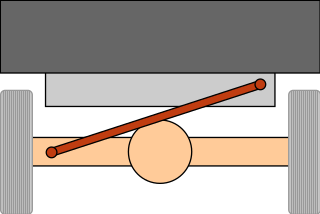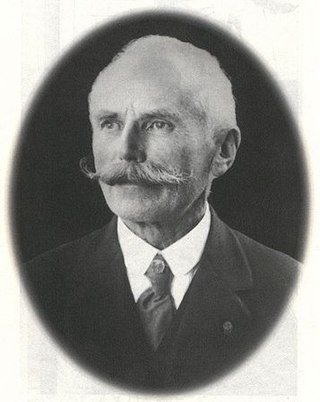Panhard is a French automotive company.
Panhard may also refer to:
- Panhard rod (Panhard suspension, Panhard) a suspension link originated by Panhard
- Panhard Nunatak (Panhard Ridge), Antarctica
- René Panhard (1841-1908) French automotive engineer
Panhard is a French automotive company.
Panhard may also refer to:
Bar or BAR may refer to:

Deutsch-Bonnet, is a brand of sports cars created in 1937 by Charles Deutsch and René Bonnet and disappeared in 1962.

A Panhard rod is a suspension link that provides lateral location of the axle. Originally invented by the Panhard automobile company of France in the early twentieth century, this device has been widely used ever since.

A multi-link suspension is a type of vehicle suspension with one or more longitudinal arms. A wider definition can consider any independent suspensions having three control links or more multi-link suspensions. These arms do not have to be of equal length, and may be angled away from their "obvious" direction. It was first introduced in the late 1960s on the Mercedes-Benz C111 and later on their W201 and W124 series.

Panhard was a French motor vehicle manufacturer that began as one of the first makers of automobiles. It was a manufacturer of light tactical and military vehicles. Its final incarnation, now owned by Renault Trucks Defense, was formed by the acquisition of Panhard by Auverland in 2005, and then by Renault in 2012. In 2018 Renault Trucks Defense, ACMAT and Panhard combined under a single brand, Arquus.

The Brass Era is an American term for the early period of automotive manufacturing, named for the prominent brass fittings used during this time for such features as lights and radiators. It is generally considered to encompass 1896 through 1915, a time when cars were often referred to as horseless carriages.
STB or StB may refer to:

A torque tube system is a power transmission and braking technology that involves a stationary housing around the drive shaft, often used in automobiles with a front engine and rear drive. The torque tube consists of a large diameter stationary housing between the transmission and rear end that fully encloses a rotating tubular steel or small-diameter solid drive shaft that transmits the power of the engine to a regular or limited-slip differential. The purpose of a torque tube is to hold the rear end in place during acceleration and braking. Otherwise, the axle housing would suffer axle wrap, such that the front of the differential would lift up excessively during acceleration and sink down during braking. Its use is not as widespread in modern automobiles as is the Hotchkiss drive, which holds the rear end in place and prevents it from flipping up or down, during acceleration and braking, by anchoring the axle housings to the leaf springs using spring perches.

The Panhard Dyna Z is a lightweight motor car produced by Panhard of France from 1954 to 1959. It was first presented to the press at a Paris restaurant named Les Ambassadeurs on 17 June 1953 and entered production the following year. In 1959, it was replaced by the Panhard PL 17.

Auverland, now grouped with Panhard, is a French manufacturer of Jeep-like four-wheel-drive and armoured fighting vehicles. It bought Panhard from Peugeot in April 2005, and in a reverse takeover the combined company now uses the better known Panhard name.

Arthur Constantin Krebs was a French officer and pioneer in automotive engineering.
Daimler is a German surname. It may refer to:

The Panhard EBR is an armoured car designed by Panhard for the French Army and later used across the globe, notably by the French Army during the Algerian War and by the Portuguese Army during the Overseas War.
Cusco is the Inca capital in modern Peru and the most populous city in the Andes.

The Panhard Dyna X was a lightweight berline designed by the engineer Jean Albert Grégoire and first exhibited as the AFG (Aluminium Français Grégoire) Dyna at the Paris Motor Show in 1946.

In automotive suspensions, a suspension link, control link or link is a suspension member, that attaches at only two points. One point being the body or frame of the vehicle and the other point attaching to the knuckle, upright, axle or another link. The link pivots on either a bushing or a ball joint at each attachment point. A link differs from a control arm because it can only control one of the degrees of freedom by itself.
Pan Pan may refer to:

The Dynavia is a concept car built by Panhard in 1948. It was built as an experiment in aerodynamics.
Louis Bionier (1898–1973) was a French automotive engineer. He is best known as head of chassis development and chief stylist for carbuilder Panhard. He was also involved in the design of some of Panhard's military vehicles.

Louise Sarazin, Louise Sarazin-Levassor,, played a significant role in early automotive history having been party to its beginnings in France and Germany. She was the wife of Edouard Sarazin, an entrepreneurial Belgian industrialist and patents lawyer who was in a mix of automotive partnerships and agencies with Émile Levassor, René Panhard, John Cockerill, Deutz AG, Gottlieb Daimler and Wilhelm Maybach. In 1884 Sarazin acquired the licence to build Deutz engines in France, which he duly contracted to Perin, Panhard & Cie in Paris. Around 1886 he similarly acquired licences to build Daimler engines in France and started to commission Panhard & Levassor in Paris. After his death in 1887 his widow Louise developed the business relationships and negotiated the partnerships with Daimler and 'Panhard et Levassor'. In 1890 she married Emile Levassor.